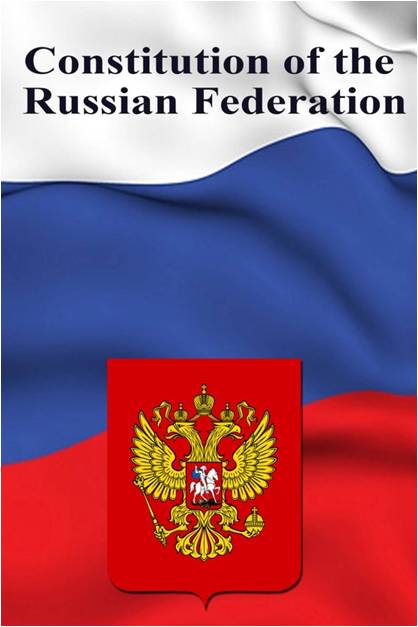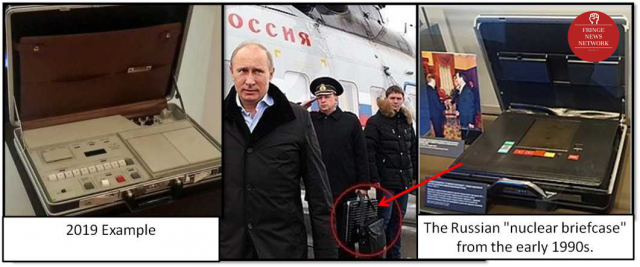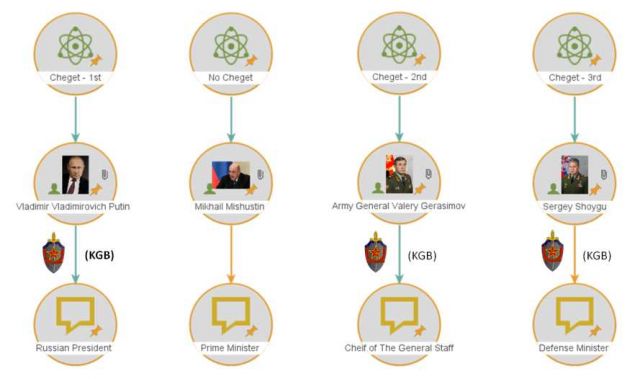Fringe News Network: Russian’s Nuclear Launch Authority and Process
March 12, 2022
Phillip Turner
Fringe News Network (Texarkana, TX)
What is the Russian nuclear button?
Cheget (Russian: Чегет) is a “nuclear briefcase” (named after Mount Cheget in Kabardino-Balkaria, Russia) and a part of the automatic system for the command and control of Russia’s Strategic Nuclear Forces (SNF) named Kazbek (Казбек, after Mount Kazbek). The Cheget was introduced into service in 1983. There are three cheget (briefcases or black boxes). (Эксклюзив, 1992 & Wikipedia) The red button is what we in the United States refer to the nuclear button; however, the launch button is actually white. “One of the briefcase’s components is a flash card with the nuclear codes on it. This flash card is singular and contains the code that is entered into the system. (Alexei Yegorov & The U.S. Sun, 2019)
Who has access to the Russian nuclear button?
One Cheget accompanies the Russian president, Vladimir Putin, wherever he goes. The Cheget allows the president to monitor a missile crisis, make decisions, and transmit those decisions to the military. According to the 1993 Russian Constitution, the president is the commander in chief, and if incapacitated in any way, all of his duties fall to the prime minister. Yet the prime minister does not have a nuclear briefcase at his disposal. The two Cheget briefcases are actually held by the defense minister and the chief of the general staff. (Foreign Policy, 2010)
Who has the authority to use the Russian nuclear button?
The guidance for Russia’s nuclear launch authority is covered in the 1993 Russian constitution and Russian military doctrine.
Under Article 87.1 of the Russian Constitution, the President is the Supreme Commander-in -Chief
of the Armed Forces, and the Law On Defence states that the Supreme
Commander-in-Chief is the ultimate authority on all nuclear-related
matter. (Russian Govt, 2008) Additionally, the current Russian military
doctrine states that “The decision to use nuclear weapons shall be taken
by the President of the Russian Federation.” To that end, the President
possesses a Cheget briefcase, which allows the President to monitor
strategic crises and transmit nuclear command decisions through the
Kazbek command and control network, using the Kavkaz special
communications system. (FAS, 2020)
-Chief
of the Armed Forces, and the Law On Defence states that the Supreme
Commander-in-Chief is the ultimate authority on all nuclear-related
matter. (Russian Govt, 2008) Additionally, the current Russian military
doctrine states that “The decision to use nuclear weapons shall be taken
by the President of the Russian Federation.” To that end, the President
possesses a Cheget briefcase, which allows the President to monitor
strategic crises and transmit nuclear command decisions through the
Kazbek command and control network, using the Kavkaz special
communications system. (FAS, 2020)
In addition to the President, it is widely believed that both the Defense Minister and the Chief of the General Staff also possess Cheget briefcases, although ultimate launch authority rests with the President. Given the tremendous secrecy surrounding Russian nuclear launch authority, these extra briefcases pose a bit of a mystery. It is possible that the additional two briefcases might act as a form of validation or check against the President’s nuclear launch decision (this is implied in Valery E. Yarynich’s C3: Nuclear Command, Control, Cooperation, in which he states that these three individuals “together prepare the authorization for the use of nuclear weapons”); however, given that neither the Defense Minister nor the Chief of the General Staff are constitutionally or doctrinally designated as nuclear decision-makers, it seems more likely that their briefcases would function as (potentially necessary) links in the chain of command, which would be used to transmit the President’s nuclear launch order down to the relevant launch and warhead custodial units. (Yarynich, 2003)
In Russia, there is not one but three “Chegets” (strategic communication devices): one for the president, one for the defense minister, and one for the chief of general staff. Some claim that the agreement of all three authorities (plus that of one of the strategic forces commanders) is needed to launch a nuclear strike. (The Twilight of the Bombs, 2010) But most informed sources state that any of the three can launch a nuclear strike. (War Scare, 1991) What seems clear in any case is that nuclear use does not technically require any input from the Russian president.(This was the case in the Soviet Union.) (The Logic of Accidental Nuclear War, 1993) A well-known Russian expert has stated that “real control over nuclear weapons has never been in the hands of the political leadership. It has always been under the control of the defense minister and the General Staff.” (War Scare, 1991) He wrote more recently that “It is not clear whether the system is fail-safe from the action of reckless military commanders.” War Scare, 1993) Indeed, other testimonies have stated that, technically, the ability to launch nuclear weapons exists well below the upper echelons of Russian political and military power. (War Scare, 1993)
What is the process for launching a Russian nuclear device?
Step 1: (Transmit Emergency Action Message) President, Minister of Defense, and the C
 hief
of the Staff, transmitting an Emergency Action Message (EAM) to the
nuclear triad units to execute specific Major Attack Options or Limited
Attack Options.
hief
of the Staff, transmitting an Emergency Action Message (EAM) to the
nuclear triad units to execute specific Major Attack Options or Limited
Attack Options.
Step 2: (Authentication) – It is used the automated control system of nuclear forces Kazbek (автоматизированная система управления ядерными силами страны “Казбек”), which key node is in 3 nuclear briefcases, Cheget (Абонентский комплекс “Чегет” автоматизированной системы управления стратегическими ядерными силами “Казбек”).
Step 3 (System is Activated) – Upon receiving warnings about a
nuclear attack, the leader could activate the system, and then wait for
further developments, assured by the fact that even the destruction of
all key personnel with the authority to command the response to the
attack could still not prevent a retaliatory strike, resulting in Mutual
assured destruction or mutually assured destruction (MAD).
Thus, this eliminates the possibility of a false-alarm-triggered retaliation.
Notes: “Dead hand”, or “Perimeter”, is as an alternative system for all units armed with nuclear weapons. It is a backup communication system, in case the key components of the “Kazbek” command system and the link to the Strategic Missile Forces are destroyed by a first-strike in accordance with the concept developed in the US called “Limited nuclear war”. In order to ensure its functionality the system was originally designed as fully automatic, and with the ability to decide on the adequate retaliatory strike on its own with no (or minimal) human involvement in the event of an all-out attack. According to a developer of the system, it is a buffer against hasty decisions based on unverified information by the country’s leadership.
https://beforeitsnews.com/war-and-conflict/2022/03/russians-nuclear-launch-authority-and-process-2474674.html
https://twitter.com/fringenewsJames/status/1503118893354684416
https://twitter.com/fringenewsJames/status/1503111933393727488
https://twitter.com/fringenewsJames
https://beforeitsnews.com/v3/contributor/stories/?uid=851735




Comments
Post a Comment